There are seven different subspecies of robins in the world. The white-headed robin-chat, Cossypha heinrichi, is a bird that belongs to the family Muscicapidae. The white-headed robin-chat, Cossypha heinrichi, is a migratory bird and migrates yearly. The white-headed robin-chat, Cossypha heinrichi, is a carnivorous bird.
The white-headed robin-chat, Cossypha heinrichi, is seen primarily in the Democratic Republic of Congo and Northern Angola. The white-headed robin-chat, Cossypha heinrichi, population is classified as Vulnerable.
Habitat loss is a major factor that has led to major impacts on its distribution and sustenance. The white-headed robin-chat, Cossypha heinrichi, is distinguished owing to its white-headed appearance, which sets it apart from other birds. White-headed robin-chat, Cossypha heinrichi, birds were protected specifically by a group of birdwatchers near the community of Kinjila.
White-headed robin-chat, Cossypha heinrichi, birds are scarcely seen in other parts of the world. Read on to discover more.
For more relatable content, check out these bee eater and blue jay facts.
White-Headed Robin-Chat Interesting Facts
What type of animal is a white-headed robin-chat?
The white-headed robin-chat, Cossypha heinrichi, is a type of bird and is endemic to Angola and the Democratic Republic of Congo.
What class of animal does a white-headed robin-chat belong to?
The white-headed robin-chat, Cossypha heinrichi, is a type of bird that belongs to class Aves, family Muscicapidae and genus Cossypha. It is part of the African bird club which protects birdlife.
How many white-headed robin-chats are there in the world?
The white-headed robin-chat's population size is estimated at 6000-15000 adults. The total number of individuals is estimated at 10,000-19,999. The primary reason why the population/distribution has been impacted is due to habitat loss. The range map is available online on the International Union For Conservation Of Nature red list website.
Where does a white-headed robin-chat live?
The white-headed robin-chat, Cossypha heinrichi, lives in the woods and regions with dense undergrowth. It is seen in the Democratic Republic of Congo and Northern Angola. It's rare to spot these birds owing to the fact that their status is a threat.
What is a white-headed robin-chat's habitat?
The white-headed robin-chat, Cossypha heinrichi, resides on trees in forests in the Democratic Republic of Congo and Northern Angola. The white-headed robin-chat, Cossypha heinrichi, primarily feeds on insects hence resides in trees and regions with dense undergrowth.
Who do white-headed robin-chats live with?
The white-headed robin-chat, Cossypha heinrichi, lives in both pairs as well as solitary beings in a forest. These birds come together to mate and raise their young. They are found in regions of dense undergrowth.
How long does a white-headed robin-chat live?
The white-headed robin-chat, Cossypha heinrichi, exact lifespan is not evaluated. The white-headed robin-chat, Cossypha heinrichi, life duration depends on its lifestyle and habitat. The Cape robin chat has been recorded to live up to 17 years.
How do they reproduce?
Little is known about the mating/reproductive behavior of white-headed robin-chat, Cossypha heinrichi. Other similar species are mostly monogamous; their nest is cup-shaped and made of plant material which is usually built in a tree cavity. The female mates with the male and lays three eggs per clutch.
Incubation lasts 16 days. Females are responsible for brooding the eggs. They are fed by both parents and fledge post 18 days.
What is their conservation status?
The white-headed robin-chat is classified as a Vulnerable species by the International Union For Conservation Of Nature (IUCN). These species are in extreme need of being protected.
A white-headed robin-chat range map is available on the IUCN website. They are part of the African Bird Club which consists of birdlife-related information about other species in the world. The African bird club organized efforts to conserve birdlife species.
White-Headed Robin-Chat Fun Facts
What do white-headed robin-chats look like?
The white-headed robin-chat, Cossypha heinrichi, is a beautiful bird with a white head, brown back, and orange underparts. They have a long tail. The tail has a dark center part, but the remaining parts are orange.
This particular robin has a white head, and its other parts are colored, helping you distinguish it from other species easily. Owing to its white head, its black eyes and its black beak, which are dark in color, it stands out distinctly. It has charcoal dark-colored legs and feet as well.

*Please note that the image is of a Uganda white-browed robin-chat, not a white-headed robin-chat. If you have an image of a white-headed robin-chat, please let us know at hello@kidadl.com.
How cute are they?
These species are extremely cute in appearance. They are currently found only in Angola and the Democratic Republic of Congo; hence it's rare to find them in other parts of the world. If you visit regions native to the species and come across a similar species, you probably found these unique beings or a relative of the same.
How do they communicate?
It is found that these species of birds are excellent communicators. They communicate via song and call. Their songs are found to be complex, including musical whistles, which are variable, as well as other types of notes. Their call is a raising whistle.
These species are also found communicating via body language. Their songs are distinct and loud. Their song goes from slow to extremely loud.
How big is a white-headed robin-chat?
The white-headed robin-chat is 8.7-9.1 in (22-23 cm) in length, which is four times bigger than the bee hummingbird, which is 2.1-2.4 in (5.5-6.1 cm).
How fast can a white-headed robin-chat fly?
The exact flying speed of these species is not evaluated. They are moderately active birds. The fastest bird is the peregrine falcon.
How much does a white-headed robin-chat weigh?
The white-headed robin-chat, Cossypha heinrichi, weighs 2-2.4 oz (56- 69 g). The white-headed robin-chat, Cossypha heinrichi, constitutes a major part of the birdlife in African continents.
What are the male and female names of the species?
Male and female species are not addressed differently. Females tend to have a shorter tail than males; they also differ in reproductive functions.
What would you call a baby white-headed robin-chat?
A baby white white-headed robin-chat (Cossypha heinrichi) is called a chick or a juvenile head, and the nest is buffish brown, and their back has buff spots that are orange in color. Juveniles are dependent on their parents in the initial few weeks of their life.
What do they eat?
These birds are primarily carnivores and feed on flying insects like the dragonfly as well as the driver or black carpenter ant and others. They feed the same to the juveniles.
Are they poisonous?
No, these species of birds are not poisonous or dangerous. Their instant response to any danger is their flight instinct.
Would they make a good pet?
No, these species are endemic to forest regions in Africa. They range in their natural habitat and are classified as Vulnerable species. It's difficult to see such species in other regions of the world. You could consider adopting birds that are smaller in size and range in your region.
Did you know...
The smallest bird egg is that of a hummingbird and is the size of a pea. The largest bird egg of a bird is that of an ostrich. Some breeds of chickens are known to lay eggs of different colors.
The first bird ever to be domesticated was a goose. All other domesticated birds, including chickens, followed the goose.
Male species of most birds are more brightly colored and have rufous plumage as compared to the female species; however, in certain birds, males and females are similar in appearance, like the white-headed robin-chat, which has a rufous plumage and is similarly colored but varies in size and features slightly.
What's special about white-headed robin-chats?
The white-headed robin-chat has a white head. This white head sets them apart from other birds of their own kind as well as other bird species. These bird species are endemic to/limited to certain regions of the world. This bird is protected by a group of birdwatchers.
How did white-headed robin-chats get their name?
Robin came from a colonial era when all orange to red-colored birds were named in like manner in history. This naming continued for other similar species. Robin chats are birds that are territorial and monogamous during their breeding season/mating season. The white-headed robin-chat has a white head which sets them apart from other bird species.
Robin species are native to America, including the American robin, all of which are red to orange colored. You could consider visiting the Bombo Lumene National park in Africa to see these exotic beings. Such places are one of the last regions where you can spot such birds.
Here at Kidadl, we have carefully created lots of interesting family-friendly animal facts for everyone to discover! Learn more about some other birds from our Amazon parrot facts and blue tit facts pages.
You can even occupy yourself at home by coloring in one of our White-Headed Robin-Chat coloring pages.









